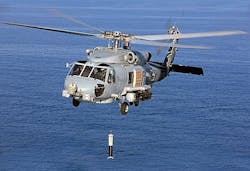Navy awards $65.8 million order to Raytheon to provide 22 helicopter dipping sonar systems
Officials of the Naval Air Systems Command at Patuxent River Naval Air Station, Md., are asking the Raytheon Integrated Defense Systems segment in Portsmouth, R.I., to provide AN/AQS-22 Airborne Low Frequency Sonar (ALFS) systems for anti-submarine warfare (ASW).
Of these 22 airborne sonar systems, 20 are for the U.S. Navy and two are for the government of Saudi Arabia. The ALFS dipping sonar is the primary undersea warfare sensor of the MH-60R multi-mission helicopter.
The sonar system enables the MH-60R to detect, track, pinpoint, and classify potentially hostile submarines. It reels the sonar transducer down into the water from the hovering helicopter and can operate the sonar at a wide variety of depths to find submarines hiding under temperature inversions in the water.
Related: Sonar technology comes to grips with dangerous new era
The AN/AQS-22 sonar can be deployed aboard the MH-60R helicopter from a variety of surface ships and land bases. The sonar-equipped submarine can operate from any air-capable frigate, destroyer, cruiser, fast combat support ship, amphibious assault ship, or aircraft carrier.
The AQS-22 is designed to detect and classify hostile submarines at greater ranges than currently deployed dipping sonar systems, and can reach depths near 2,500 feet while deployed from the helicopter on a hardened coaxial cable tether.
Raytheon teams on the AQS-22 with Thales Underwater Systems in Brest and Sophia, France. Thales manufactures the system’s hydrophone stave arms, as well as the active transducer system.
story continues below
The sonar system has seven weapon-replaceable assemblies: the acoustic processor equipment, sonar transmitter/receiver, reeling machine interface unit, reeling machine control unit, reeling machine, reel and cable, and the transducer assembly.
The hydrophone staves use beam forming and signal processing to detect the presence of submarines and to determine the submarine’s location, range, and bearing.
Key components of the AQS-22’s signal-processing system are field programmable gate arrays, as well as single-board processors from Curtiss-Wright Embedded Computing in Ottawa, says Lawrence Epstein, director of engineering at Raytheon Integrated Defense Systems.
The AN/AQS-22 is capable of multi-frequency operation that enables the AN/AQS-22 to adapt its performance to varying environmental conditions, and permits a long detection range over a wide area.
Related: Last of eight Royal Navy Duke-class frigates receives Thales sub-hunting toward-array sonar
Power to the AN/AQS-22 ALFS is supplied by the helicopter, eliminating the need for in-unit sonar batteries. The Raytheon-Thales partnership builds about 20 full-rate AN/AQS-22 production systems per year, as well as provides spare parts and systems support.
On this contract modification Raytheon will do the work in Brest, France; Portsmouth, R.I.; and Johnstown, Pa., and should be finished by September 2018.
For more information contact Raytheon Integrated Defense Systems online at www.raytheon.com, or Naval Air Systems Command at www.navair.navy.mil.
